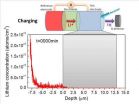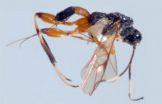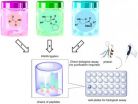(Press-News.org) With climate change threatening global food supplies, new research claims the rich flora of China could be crucial to underpin food security in the future.
A team from the University of Birmingham and partners in China have identified 871 wild plant species native to China that have the potential to adapt and maintain 28 globally important crops, including rice, wheat, soybean, sorghum, banana, apple, citrus fruits, grape, stone fruits and millet. 42% of these wild plant species, known as crop wild relatives (CWR) occur nowhere else in the world.
CWR are wild plant species closely related to crops which grow under a broad range of environmental conditions in their natural habitats and are therefore much more genetically variable. Their adaptive traits can be transferred to crops to improve tolerance to extreme environmental conditions and exposure to different pests and diseases, which helps sustain food production. Furthermore, they can be utilised to improve the nutritional and marketing qualities of crops.
Examples of China's CWR successfully used to improve crops include: Oryza rufipogon, a wild relative of rice, utilised to confer tolerance to drought and aluminium toxicity; Glycine soja, used to improve protein content in soybean; and Vitis amurensis, a wild relative of grape, which has been used to improve cold tolerance.
Worryingly, of these 871 CWR native to China, at least 17% are threatened with extinction in China and require urgent conservation action. This includes wild relatives of 16 crops that are globally threatened because they do not occur anywhere else in the world.
The flora of China comprises more than 20,000 native higher plant species, a proportion of which have value as gene donors for crop improvement. However, until now, the full range of these potentially valuable CWR species had not been identified.
The research carried out by academics from the University of Birmingham represents a significant contribution to global research in plant genetic resources for food and agriculture, particularly in the fight against the detrimental impacts of climate change on food security. The research in China is based upon methodologies developed and applied by the University's research team in Europe, but it is the first survey of its kind anywhere else in the world.
Now a comprehensive database of CWR for China exists and the priority species have been identified, the next step is to systematically conserve their diversity in situ and via gene banks to ensure their wealth of resilient characteristics are available to plant breeders.
Shelagh Kell, Research Fellow, School of Biosciences said:
"China has remarkable wild plant diversity. With more plant species than Europe and CWR of globally important food crops, its position as a provider of plant genetic resources for crop improvement is crucial to us all globally. Now that we have identified China's priority CWR and some of the hotspots in which they occur, stakeholders need to implement a strategy to secure their future.
"Conservation planning and plant breeding knowledge is very advanced but the politics of establishing a network for in situ protection of CWR and for accessing plant material for crop improvement is incredibly complex. However, urgent attention needs to be paid to China's CWR to ensure that they are adequately conserved, so that this diversity is available for use in crop improvement programmes before it is lost forever."
INFORMATION: END
Plant diversity in China vital for global food security
2014-09-08
ELSE PRESS RELEASES FROM THIS DATE:
Plant insights could help develop crops for changing climates
2014-09-08
Crops that thrive in changing climates could be developed more easily, thanks to fresh insights into plant growth.
A new computer model that shows how plants grow under varying conditions could help scientists develop varieties likely to grow well in future.
Scientists built the model to investigate how variations in light, day length, temperature and carbon dioxide in the atmosphere influence the biological pathways that control growth and flowering in plants.
They found differences in the way some plant varieties distribute nutrients under varying conditions, ...
First-ever look inside a working lithium-ion battery
2014-09-08
VIDEO:
Using a neutron beam, chemists and engineers at The Ohio State University were able to track the flow of lithium atoms into and out of an electrode in real time...
Click here for more information.
COLUMBUS, Ohio—For the first time, researchers have been able to open a kind of window into the inner workings of a lithium-ion battery.
Using a neutron beam, chemists and engineers at The Ohio State University were able to track the flow of lithium atoms into and out ...
Targeted immune booster removes toxic proteins in mouse model of Alzheimer's disease
2014-09-08
Alzheimer's disease experts at NYU Langone Medical Center and elsewhere are reporting success in specifically harnessing a mouse's immune system to attack and remove the buildup of toxic proteins in the brain that are markers of the deadly neurodegenerative disease.
Reporting on their experiments in the journal Acta Neuropathologica Communications online Sept. 3, the researchers say the work advances the development of more effective clinical treatments for Alzheimer's because their immune booster reduced both amyloid beta plaques and tau tangles. Previous immunomodulatory ...
Nearly half of older adults have care needs
2014-09-08
Nearly half of older adults – 18 million people—have difficulty or get help with daily activities, according to a new study.
Researchers from the University of Michigan and the Urban Institute analyzed data from a national sample of older adults drawn from Medicare enrollment files. In all, 8,245 people were included in the 2011 the National Health and Aging Trends Study. The analysis was published in the current (September 2014) issue of the Milbank Memorial Quarterly.
"Although 51 percent reported having no difficulty in the previous month, 29 percent reported receiving ...
The future of our crops is at risk in conflict zones, say Birmingham scientists
2014-09-08
Wild species related to our crops which are crucial as potential future food resources have been identified by University of Birmingham scientists, however, a significant proportion are found in conflict zones in the Middle East, where their conservation is increasingly comprised.
The scientists have identified 'hotspots' around the globe where crop wild relatives (CWR) – species closely related to our crops which are needed for future crop variety development – could be conserved in the wild in order to secure future global food resources.
The hotspot where CWR ...
New parasitoid wasp species found in China
2014-09-08
For the first time, wasps in the genus Spasskia (family: Braconidae) have been found in China, according to an article in the open-access Journal of Insect Science. In addition, a species in that genus which is totally new to science was also discovered.
The new species, Spasskia brevicarinata, is very small — male and female adults are less than one centimeter long. It is similar to a previously described species called Spasskia indica, but the ridges on some of its body segments are different. In fact, the species epithet brevicarinata reflects a short ridge on its ...
Unusual immune cell needed to prevent oral thrush, Pitt researchers find
2014-09-08
PITTSBURGH, Sept. 8 – An unusual kind of immune cell in the tongue appears to play a pivotal role in the prevention of thrush, according to the researchers at the University of Pittsburgh School of Medicine who discovered them. The findings, published online today in the Journal of Experimental Medicine, might shed light on why people infected with HIV or who have other immune system impairments are more susceptible to the oral yeast infection.
Oral thrush is caused by an overgrowth of a normally present fungus called Candida albicans, which leads to painful white lesions ...
'Pick 'n' Mix' chemistry to grow cultures of bioactive molecules
2014-09-08
Chemists at ETH-Zürich and ITbM, Nagoya University have developed a new method to build large libraries of bioactive molecules – which can be used directly for biological assays – by simply mixing a small number of building blocks in water.
Zürich, Switzerland and Nagoya, Japan – Professor Jeffrey Bode of ETH-Zürich and the Institute of Transformative Bio-Molecules (ITbM) of Nagoya University, and his co-worker have established a new strategy called "synthetic fermentation" to rapidly synthesize a large number of bioactive molecules, which can be directly screened in ...
Trial shows improved overall survival for patients with liver cancer not amenable to surgery
2014-09-08
Singapore, 04 September 2014 – The mature results from a trial conducted by the Asia-Pacific Hepatocellular Carcinoma Trials Group led by the National Cancer Centre Singapore (NCCS) and Singapore General Hospital (SGH) have shown that patients who suffer from inoperable advanced hepatocellular carcinoma (HCC) may have a chance to live significantly longer by using a combined therapy.
The multi-centre phase II clinical trial was conducted at four Asia Pacific tertiary medical centres to evaluate the efficacy of combining two existing treatment modalities, Sorafenib and ...
New knowledge of cannabis paves the way for drug development
2014-09-08
Revolutionary nanotechnology method could help improve the development of new medicine and reduce costs. Researchers from the Nano-Science Center and the Department of Chemistry at the University of Copenhagen have developed a new screening method that makes it possible to study cell membrane proteins that bind drugs, such as cannabis and adrenaline, while reducing the consumption of precious samples by a billion times.
About 40% of all medicines used today work through the so-called "G protein-coupled receptors". These receptors react to changes in the cell environment, ...


